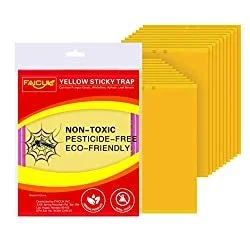How To Get Rid Of Fungus Gnats
Probably one of the peskiest and most frustrating pests you will encounter in your indoor houseplant journey. Let's talk about what fungus gnats are and how we get rid of them!
What is a Fungus Gnat
First, let's talk about what a fungus gnat is and how they affect your houseplants.
Fungus gnats also called mushroom flies and sciarid flies, are tiny, flying insects that lay larvae in your potting soil (ew, I know). They lay about 200 eggs a day. When these eggs hatch, the larvae feed on decaying matter and roots in the soil. Some species of these gnats are capable of seriously damaging your plants, most specifically seedlings.
The larvae are what you have to watch out for. Yes, the adult flies are flying around depositing disgusting eggs into your soil, but they don't harm your plants too much. The larvae they deposit do. These larvae will attach to the roots of your houseplants and feed on the nutrients. In other words, they will devour your plant roots. Inevitably killing your plant.
So, let us talk about how you can prevent them and overcome an infestation.
Products for Fungus Gnat Prevention:
These products will help prevent fungus gnats before they even decide to lay their death eggs in your plants.
These bad boys are amazing! I have been using them for a year now and I won't go back. Gnats are attracted to the color yellow, so they just fly on over to it and get stuck! These traps are perfect for smaller houseplants. This brand is non-toxic, eco-friendly, pesticide-free, and approved for organic farming!
It also comes with a cute, little shovel you can use to dig a little hole for the trap. Ridiculous I know, but I have an obsession with small things.
If you have a bigger houseplant or outdoor plant, these traps are perfect. They are dual-sided and come with wire ties so you can easily hang them. This brand is also non-toxic, pesticide-free, and eco-friendly. You can also cut them to be whatever size you need. These are for trapping the adult flying gnats.
Sand or top dressing is perfect for preventing the fungus gnats from laying eggs in your soil. Simply cover your potting mix with a small layer of sand and you are good to go. This creates a barrier that the gnats cannot get through. If they can't lay the eggs, they can create an infestation.
Sand is also very decorative and improves water drainage, so if you don't want the yellow traps, this option is perfect for you!
Organic Options for Eliminating Fungus Gnats
Here are some options for when you already have a fungus gnat infestation and need to get rid of them!
Apple cider vinegar can be used to make a trap! Simply find a shallow container and fill it with equal parts water and apple cider vinegar. Put a few drops of liquid dish soap and mix. Cover with plastic wrap and puncture a few holes in it. Place the trap near the base of your infected plant or on top of the soil. They will be able to enter, but they won't be able to escape (muhaha)!
Be sure to check on your trap to refresh with water and vinegar.
A peroxide solution will kill larvae and eggs on contact. This will kill off infant gnats and disrupt the lifecycle (bingo).
Mix 1 part hydrogen peroxide with 4 parts water. Allow the top 2 inches of soil to completely dry out. Then water your plants with the peroxide solution. It will fizz, but don't worry it won't hurt your plants. Do this one a week until the fungus gnats are gone.
Neem oil is a naturally occurring pesticide found in the seeds of a neem tree. This oil can be used for a multitude of houseplant pest problems!
To get rid of fungus gnats it can be used as a soil drench, like the peroxide solution listed above. Dilute neem oil with water per manufacturer's directions. Then drench the soil. You can also spray the leaves and topsoil to keep the gnats away.
Just remember pests are going to happen, especially during the growing season. It's not a big deal. Just make sure you are checking the soil you buy from stores, and monitoring your plants. Catching a pest problem earlier is a lot better than having a full-blown infestation (obviously).
As always, Happy planting!
Savannah
**Plant Savvy is a participant in the Amazon Services LLC Associates Program, an affiliate advertising program designed to provide a means for sites to earn advertising fees by advertising and linking to amazon.com.






